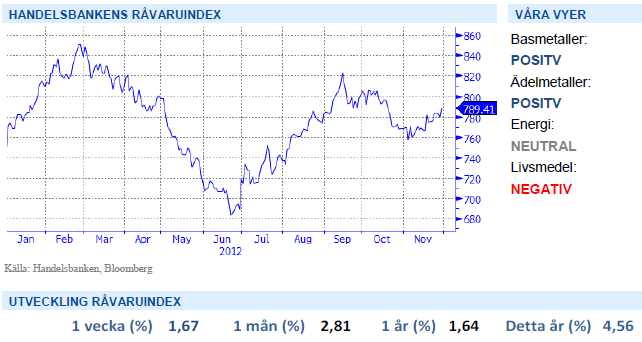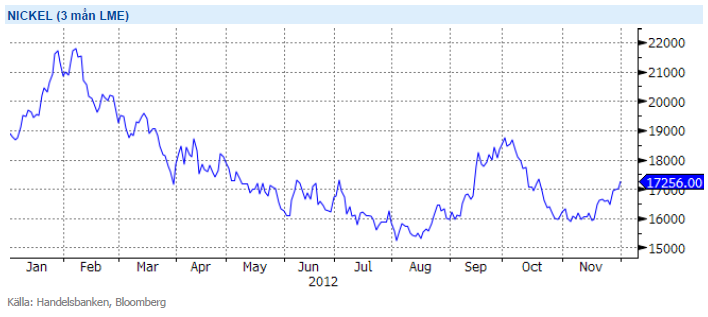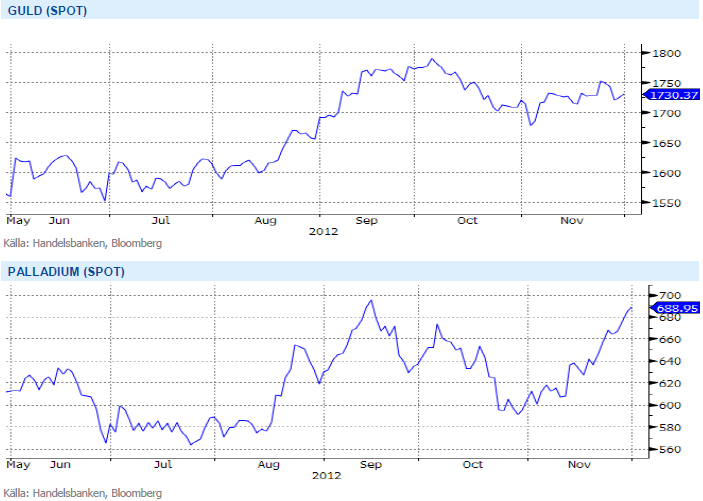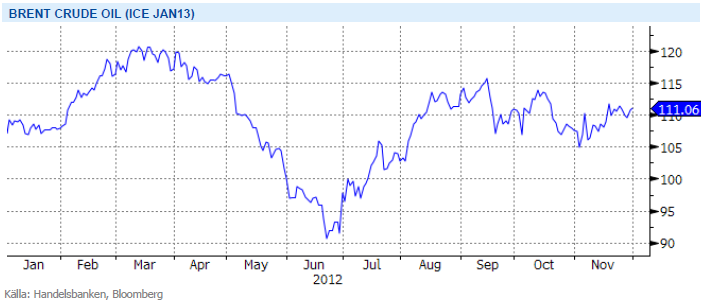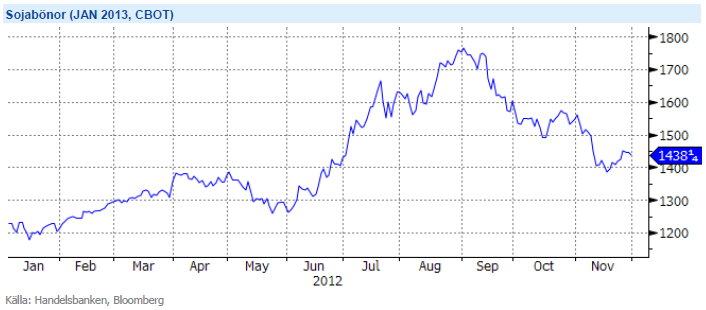Analys
SHB Råvarubrevet 30 november 2012
 Råvaror allmänt
Råvaror allmänt
Fiscal cliff fortsätter att spöka
Oron för fiscal cliff i USA tynger råvarumarknaden överlag och oljemarknaden i synnerhet (USA står för lite drygt en fjärdedel av den globala oljekonsumtionen). Detta är dock inget nytt, USA har ett budgetunderskott på 9 % av BNP och en statsskuld på närmare 110 % av BNP, så oron kommer att bestå under en lång tid. På kort sikt är det dock intressant att se om man kan nå en överrenskommelse, annars väntar åtstramningar på uppemot 600 miljarder dollar enligt de värsta pessimisterna (detta skulle motsvara 4 % av BNP vilket med största sannolikhet kastar USA tillbaka i recession vilket är allvarligt för den globala ekonomin).
Vi tror dock inte att det blir så illa (den politiska oförmågan att komma överens har tidigare skapat problem ex Standard & Poor´s nedgradering etc) så även om det innebär åtstramningar räknar vi att de blir mindre och att man kan hantera det. Inget nytt konkret och långsiktigt vad gäller Europas skuldkris gör att Kina återigen hamnar i fokus där penning och finanspolitik stödjer våra tillväxtförväntningar de kommande månaderna. Positiv dataskörd signalerar att den inhemska tillverkningsindustrin bottnar ut och indikativa PMI siffror kommer in på 13-månaders högsta nivå vilket ger stöd åt råvaror och metaller i synnerhet.
Basmetaller
Inga extrema prisrallyn i sikte
För basmetaller överlag så har produktionen kommit ikapp efter år av svag balans, detta var det allmänna intrycket från årets LME vecka under oktober vilket gör att vi inte förväntar oss några extrema prisrallyn på någon metall. Driftsättningen av nya gruvor är en stor utmaning för att möta en växande efterfrågan på lite längre sikt men på kort sikt ser balansen god ut. Utvecklingen i Kina gör dock att vi är positiva till basmetaller just nu. Flertalet har passat på att beta av lager (på stål och stålråvaror i synnerhet) som man nu försöker bygga upp igen vilket innebär orderingångar.
Ser vi till nickel skjuts flertalet investeringar på framtiden men vi räknar med en fortsatt produktionsökning om ca 5 % vilket gör att det inte finns utrymme för ett rally, speciellt inte när den globala rostfria sektorn är under fortsatt press. Vi räknar dock fortsatt med att nickelmarknaden är volatil, inte lika volatil som mellan 2007 och 2009 (när nickel föll från 50,000 dollar till under 10,000 dollar), där nivåer på 16,000 fungerar som stöd eftersom vi räknar med ett visst produktionsbortfall givet höga energi och lönekostnader. Våra prognoser ligger oförändrat på 17,500 USD för 2013 och 2014 för att sedan gå mot 18,000 USD vilket innebär en svag uppgång från dagens nivåer om 16,900 dollar.
Under oktober har basmetallerna haft ett kraftigt ras, efter den kraftiga uppgången i september. Finansmarknaden hade handlat in för mycket på för kort tid. Däremot ser Kinadata allt bättre ut nu. Vi tror på: BASMET H
Ädelmetaller
Volatila priser för de ädla metallerna
Ädelmetallerna har haft en stökig vecka där nyheter kring fiscal cliff har skickat priset både upp och ner. Guldet handlas i skrivande stund till 1730 USD/uns vilket är 1,3% lägre än förra fredagens stängning. Platinum och silver, som precis som guldet handlades ned kraftigt under onsdagen, stänger veckan i princip oförändrad. Palladium är veckans vinnare med en uppgång på 3,46%.
Guldet har ”stått och stampat” ett tag nu, även om det stigit med fem procent sedan senaste botten i början av november. Samtidigt är vi 150 dollar ifrån all-time-high på 1 900 per uns, noterat i september förra året. Vi anser att trots de höga nivåerna så är guldet köpvärt, åtminstone på kort sikt. Den viktigaste drivkraften är den stimulanspolitik som drivs just nu av världens centralbanker. Den gynnar guldet på två sätt, dels leder de exceptionellt låga räntorna till att man inte behöver avstå räntan för att äga guld. Men dessutom börjar alltfler nu undra om inte all denna stimulans till slut skapar inflation. Och just inflationsförväntan – inte inflationen själv – tror vi kan vara nog för att skicka guldet till nya rekordpriser ganska snart. Guldets stabilitet i orostider brukar vara det starkaste skälet till att äga guld, men inflationsskyddet kan visa sig vara en minst lika stark anledning att ha lite guld som komplement i sparportföljen.
Vi är fortsatt positiva till ädelmetaller med den främsta anledningen att vi tror på fortsatt mjuk penningpolitik från FED och att central bankernas stimulanser forstätter att ge stöd. Vi tror på: ADELMET H
Energi
Fortsatt riskpremie för oljan
Riskpremien på oljan har minskat något efter vapenstilleståndet i Gaza förra veckan men vi förväntar oss en fortsatt premie för den politiska oron som kan komma att påverka oljeleveranser från regionen. Något som också ger stöd är amerikansk lagerdata (senast 0,7 miljoner fat lägre än väntat). Även om råoljelagren är över normalen för perioden ser det betydligt värre ut på destillat och uppvärmningsolja i synnerhet, speciellt eftersom vi nu går mot en period av hög förbrukning i Nordöstra USA. Oljan handlas nu i nivå med bankens prognos på 110 dollar för 2013 (114 dollar för 2014).
Ny kapacitet har kommit till tack vare den höga prisnivån (speciellt skifferoljan från Bakken och Ford Eagle i Nordamerika har överraskat, dock är volymerna för små för att tala om att de enskilt kan lyfta fram USA till ett oljeoberoende år 2030) men mycket av kapaciteten är på betydligt högre kostnadsnivå vilket ger stöd åt nuvarande prisintervall (skifferoljan ligger på strax under 90 dollar och framöver bör man anta denna nivå eftersom borrning sker horisontellt med ökat fokus på miljövänlig process) runt 100 dollar om priset skulle börja falla tillbaka. Vidare behöver Saudi ett pris på närmare 100 dollar för att balansera sin budget vilket också minskar sannolikheten för något kraftigt fall under 100.
Oljan har sett allt svagare ut och vi fortsätter tycka att underliggande fundamenta är väl balanserad. Vi ser även att förutsättningarna för fortsatt lågt elpris kvarstår. Vi håller en neutral syn på energisektorn.
Livsmedel
Följ sojabönor – följ väderprognoser
För sojabönor kommer det sydamerikanska vädret kommer att hamna i fokus den närmsta tiden. Precis som för majsen är förhoppningarna höga och eventuella bakslag kan få stora effekter på prisnivån, efter dåliga skördar i främst USA förlitar sig marknaden på att Sydamerika ska leverera. Fokus är därmed på vädret fram till januari och februari (Argentina störst på majs och Brasilien på sojabönor om man ska följa vädret lokalt). Stöd till prisnivån ges även från stark kinesisk efterfrågan som fortsätter köpa stora mängder (köper ca 1/5 av globala som är 250 miljoner ton).
När Kina inte kan få sojabönor från USA riktas fokus mot Sydamerika. Inga stora variationer vad gäller kinesiska importsiffror där nivån är fortsatt hög. Förväntat utgående lager i förhållande till konsumtion är tajtare på sojabönor än på både majs och vete – får man då en dålig väderutveckling i Sydamerika bör sojabönorna öka mest i pris. Därför kan det vara intressant ur ett spread-perspektiv att förslagsvis sälja majs och köpa sojabönor. Kopplingen till energimarknaden på lite längre sikt är också intressant eftersom närmare 1/3 av världens socker, 10-15 % av vegetabiliska oljor och 10-15 av spannmålet förväntas användas till bränslen om 10 år!
Vi ser soja, majs och vete som klara säljcase där vi väntar oss prisfall senast till påsk. Vi tror på: LIVSMEDEL S H
Handelsbankens Råvaruindex
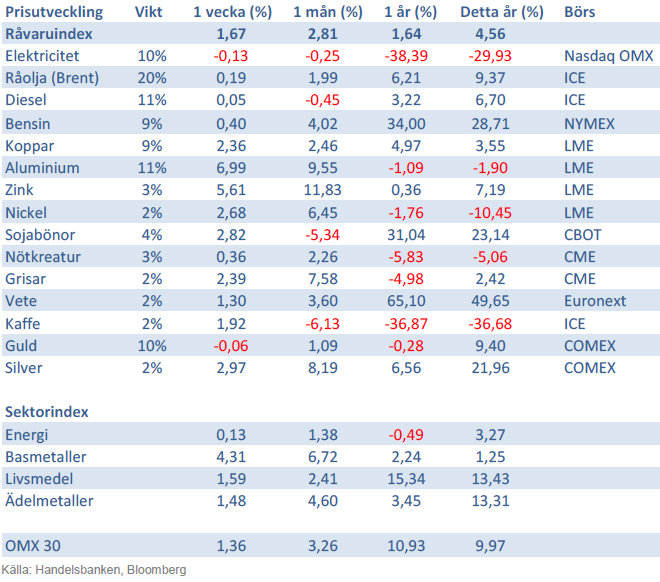
Handelsbankens råvaruindex består av de underliggande indexen för respektive råvara. Vikterna är bestämda till hälften från värdet av global produktion och till hälften från likviditeten i terminskontrakten.
[box]SHB Råvarubrevet är producerat av Handelsbanken och publiceras i samarbete och med tillstånd på Råvarumarknaden.se[/box]
Ansvarsbegränsning
Detta material är producerat av Svenska Handelsbanken AB (publ) i fortsättningen kallad Handelsbanken. De som arbetar med innehållet är inte analytiker och materialet är inte oberoende investeringsanalys. Innehållet är uteslutande avsett för kunder i Sverige. Syftet är att ge en allmän information till Handelsbankens kunder och utgör inte ett personligt investeringsråd eller en personlig rekommendation. Informationen ska inte ensamt utgöra underlag för investeringsbeslut. Kunder bör inhämta råd från sina rådgivare och basera sina investeringsbeslut utifrån egen erfarenhet.
Informationen i materialet kan ändras och också avvika från de åsikter som uttrycks i oberoende investeringsanalyser från Handelsbanken. Informationen grundar sig på allmänt tillgänglig information och är hämtad från källor som bedöms som tillförlitliga, men riktigheten kan inte garanteras och informationen kan vara ofullständig eller nedkortad. Ingen del av förslaget får reproduceras eller distribueras till någon annan person utan att Handelsbanken dessförinnan lämnat sitt skriftliga medgivande. Handelsbanken ansvarar inte för att materialet används på ett sätt som strider mot förbudet mot vidarebefordran eller offentliggörs i strid med bankens regler.
Analys
More weakness and lower price levels ahead, but the world won’t drown in oil in 2026

Some rebound but not much. Brent crude rebounded 1.5% yesterday to $65.47/b. This morning it is inching 0.2% up to $65.6/b. The lowest close last week was on Thursday at $64.11/b.

The curve structure is almost as week as it was before the weekend. The rebound we now have gotten post the message from OPEC+ over the weekend is to a large degree a rebound along the curve rather than much strengthening at the front-end of the curve. That part of the curve structure is almost as weak as it was last Thursday.
We are still on a weakening path. The message from OPEC+ over the weekend was we are still on a weakening path with rising supply from the group. It is just not as rapidly weakening as was feared ahead of the weekend when a quota hike of 500 kb/d/mth for November was discussed.
The Brent curve is on its way to full contango with Brent dipping into the $50ies/b. Thus the ongoing weakening we have had in the crude curve since the start of the year, and especially since early June, will continue until the Brent crude oil forward curve is in full contango along with visibly rising US and OECD oil inventories. The front-month Brent contract will then flip down towards the $60/b-line and below into the $50ies/b.
At what point will OPEC+ turn to cuts? The big question then becomes: When will OPEC+ turn around to make some cuts? At what (price) point will they choose to stabilize the market? Because for sure they will. Higher oil inventories, some more shedding of drilling rigs in US shale and Brent into the 50ies somewhere is probably where the group will step in.
There is nothing we have seen from the group so far which indicates that they will close their eyes, let the world drown in oil and the oil price crash to $40/b or below.
The message from OPEC+ is also about balance and stability. The world won’t drown in oil in 2026. The message from the group as far as we manage to interpret it is twofold: 1) Taking back market share which requires a lower price for non-OPEC+ to back off a bit, and 2) Oil market stability and balance. It is not just about 1. Thus fretting about how we are all going to drown in oil in 2026 is totally off the mark by just focusing on point 1.
When to buy cal 2026? Before Christmas when Brent hits $55/b and before OPEC+ holds its last meeting of the year which is likely to be in early December.
Brent crude oil prices have rebounded a bit along the forward curve. Not much strengthening in the structure of the curve. The front-end backwardation is not much stronger today than on its weakest level so far this year which was on Thursday last week.

The front-end backwardation fell to its weakest level so far this year on Thursday last week. A slight pickup yesterday and today, but still very close to the weakest year to date. More oil from OPEC+ in the coming months and softer demand and rising inventories. We are heading for yet softer levels.

Analys
A sharp weakening at the core of the oil market: The Dubai curve

Down to the lowest since early May. Brent crude has fallen sharply the latest four days. It closed at USD 64.11/b yesterday which is the lowest since early May. It is staging a 1.3% rebound this morning along with gains in both equities and industrial metals with an added touch of support from a softer USD on top.

What stands out the most to us this week is the collapse in the Dubai one to three months time-spread.
Dubai is medium sour crude. OPEC+ is in general medium sour crude production. Asian refineries are predominantly designed to process medium sour crude. So Dubai is the real measure of the balance between OPEC+ holding back or not versus Asian oil demand for consumption and stock building.
A sharp weakening of the front-end of the Dubai curve. The front-end of the Dubai crude curve has been holding out very solidly throughout this summer while the front-end of the Brent and WTI curves have been steadily softening. But the strength in the Dubai curve in our view was carrying the crude oil market in general. A source of strength in the crude oil market. The core of the strength.
The now finally sharp decline of the front-end of the Dubai crude curve is thus a strong shift. Weakness in the Dubai crude marker is weakness in the core of the oil market. The core which has helped to hold the oil market elevated.
Facts supports the weakening. Add in facts of Iraq lifting production from Kurdistan through Turkey. Saudi Arabia lifting production to 10 mb/d in September (normal production level) and lifting exports as well as domestic demand for oil for power for air con is fading along with summer heat. Add also in counter seasonal rise in US crude and product stocks last week. US oil stocks usually decline by 1.3 mb/week this time of year. Last week they instead rose 6.4 mb/week (+7.2 mb if including SPR). Total US commercial oil stocks are now only 2.1 mb below the 2015-19 seasonal average. US oil stocks normally decline from now to Christmas. If they instead continue to rise, then it will be strongly counter seasonal rise and will create a very strong bearish pressure on oil prices.
Will OPEC+ lift its voluntary quotas by zero, 137 kb/d, 500 kb/d or 1.5 mb/d? On Sunday of course OPEC+ will decide on how much to unwind of the remaining 1.5 mb/d of voluntary quotas for November. Will it be 137 kb/d yet again as for October? Will it be 500 kb/d as was talked about earlier this week? Or will it be a full unwind in one go of 1.5 mb/d? We think most likely now it will be at least 500 kb/d and possibly a full unwind. We discussed this in a not earlier this week: ”500 kb/d of voluntary quotas in October. But a full unwind of 1.5 mb/d”
The strength in the front-end of the Dubai curve held out through summer while Brent and WTI curve structures weakened steadily. That core strength helped to keep flat crude oil prices elevated close to the 70-line. Now also the Dubai curve has given in.

Brent crude oil forward curves

Total US commercial stocks now close to normal. Counter seasonal rise last week. Rest of year?

Total US crude and product stocks on a steady trend higher.

Analys
OPEC+ will likely unwind 500 kb/d of voluntary quotas in October. But a full unwind of 1.5 mb/d in one go could be in the cards

Down to mid-60ies as Iraq lifts production while Saudi may be tired of voluntary cut frugality. The Brent December contract dropped 1.6% yesterday to USD 66.03/b. This morning it is down another 0.3% to USD 65.8/b. The drop in the price came on the back of the combined news that Iraq has resumed 190 kb/d of production in Kurdistan with exports through Turkey while OPEC+ delegates send signals that the group will unwind the remaining 1.65 mb/d (less the 137 kb/d in October) of voluntary cuts at a pace of 500 kb/d per month pace.

Signals of accelerated unwind and Iraqi increase may be connected. Russia, Kazakhstan and Iraq were main offenders versus the voluntary quotas they had agreed to follow. Russia had a production ’debt’ (cumulative overproduction versus quota) of close to 90 mb in March this year while Kazakhstan had a ’debt’ of about 60 mb and the same for Iraq. This apparently made Saudi Arabia angry this spring. Why should Saudi Arabia hold back if the other voluntary cutters were just freeriding? Thus the sudden rapid unwinding of voluntary cuts. That is at least one angle of explanations for the accelerated unwinding.
If the offenders with production debts then refrained from lifting production as the voluntary cuts were rapidly unwinded, then they could ’pay back’ their ’debts’ as they would under-produce versus the new and steadily higher quotas.
Forget about Kazakhstan. Its production was just too far above the quotas with no hope that the country would hold back production due to cross-ownership of oil assets by international oil companies. But Russia and Iraq should be able to do it.
Iraqi cumulative overproduction versus quotas could reach 85-90 mb in October. Iraq has however steadily continued to overproduce by 3-5 mb per month. In July its new and gradually higher quota came close to equal with a cumulative overproduction of only 0.6 mb that month. In August again however its production had an overshoot of 100 kb/d or 3.1 mb for the month. Its cumulative production debt had then risen to close to 80 mb. We don’t know for September yet. But looking at October we now know that its production will likely average close to 4.5 mb/d due to the revival of 190 kb/d of production in Kurdistan. Its quota however will only be 4.24 mb/d. Its overproduction in October will thus likely be around 250 kb/d above its quota with its production debt rising another 7-8 mb to a total of close to 90 mb.
Again, why should Saudi Arabia be frugal while Iraq is freeriding. Better to get rid of the voluntary quotas as quickly as possible and then start all over with clean sheets.
Unwinding the remaining 1.513 mb/d in one go in October? If OPEC+ unwinds the remaining 1.513 mb/d of voluntary cuts in one big go in October, then Iraq’s quota will be around 4.4 mb/d for October versus its likely production of close to 4.5 mb/d for the coming month..
OPEC+ should thus unwind the remaining 1.513 mb/d (1.65 – 0.137 mb/d) in one go for October in order for the quota of Iraq to be able to keep track with Iraq’s actual production increase.
October 5 will show how it plays out. But a quota unwind of at least 500 kb/d for Oct seems likely. An overall increase of at least 500 kb/d in the voluntary quota for October looks likely. But it could be the whole 1.513 mb/d in one go. If the increase in the quota is ’only’ 500 kb/d then Iraqi cumulative production will still rise by 5.7 mb to a total of 85 mb in October.
Iraqi production debt versus quotas will likely rise by 5.7 mb in October if OPEC+ only lifts the overall quota by 500 kb/d in October. Here assuming historical production debt did not rise in September. That Iraq lifts its production by 190 kb/d in October to 4.47 mb/d (August level + 190 kb/d) and that OPEC+ unwinds 500 kb/d of the remining quotas in October when they decide on this on 5 October.

-

 Nyheter4 veckor sedan
Nyheter4 veckor sedanAktier i guldbolag laggar priset på guld
-

 Nyheter4 veckor sedan
Nyheter4 veckor sedanKinas elproduktion slog nytt rekord i augusti, vilket även kolkraft gjorde
-

 Nyheter4 veckor sedan
Nyheter4 veckor sedanTyskland har så höga elpriser att företag inte har råd att använda elektricitet
-

 Nyheter4 veckor sedan
Nyheter4 veckor sedanDet stigande guldpriset en utmaning för smyckesköpare
-

 Nyheter3 veckor sedan
Nyheter3 veckor sedanEtt samtal om guld, olja, fjärrvärme och förnybar energi
-

 Nyheter2 veckor sedan
Nyheter2 veckor sedanOPEC+ missar produktionsmål, stöder oljepriserna
-

 Analys4 veckor sedan
Analys4 veckor sedanBrent crude ticks higher on tension, but market structure stays soft
-

 Analys3 veckor sedan
Analys3 veckor sedanAre Ukraine’s attacks on Russian energy infrastructure working?


